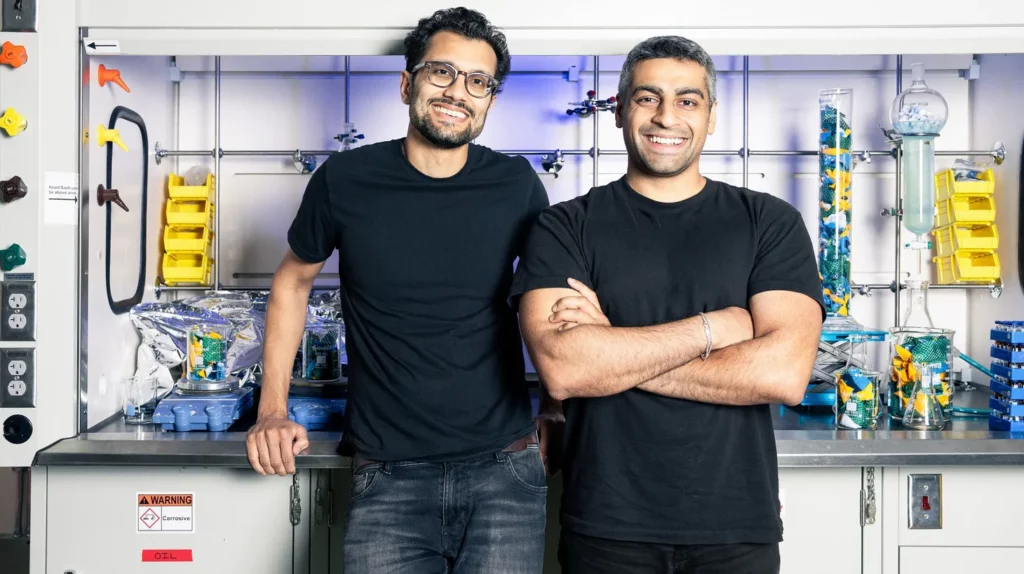Look at the labels on your clothes, and you’ll likely find that most of them have polyester: workout shirts, stretchy jeans, pantsuits, sweaters, and underwear. The synthetic fiber is made from fossil fuels, and it’s very hard to reuse it for anything once you’re done wearing clothes that contain them. In fact, 65% of what we wear ends up in landfills less than 12 months after we buy them.
LA start-up Ambercycle is trying to change that. In their Boyle Heights laboratory, chemists and engineers have figured out how to pull polyester from used clothes and package it for re-use.
“It seems so archaic to dump material on the earth, or just try and burn it and see what happens,” says Ambercycle Co-founder Shay Sethi. “We’ve developed all these crazy technologies to make stuff. Why do we not apply those to the other end of the lifecycle?”
He and his business partner, Moby Ahmed, started researching polyester as roommates in their senior year at UC Davis. Sethi is a biochemist, Ahmed graduated in Genetics and Genomics. They were both working on new waste-reducing technologies. They realized that recycling methods like those used for plastic bottles weren’t sustainable because utilizing extreme heat to melt the material compromises the quality, and it can only be repeated a few times.
 A shredder turns discarded clothes into pieces before a chemical process separates polyester from the fabric. Photo courtesy of Ambercycle.
A shredder turns discarded clothes into pieces before a chemical process separates polyester from the fabric. Photo courtesy of Ambercycle.
They developed chemical processes to extract polyester from clothes and turn it into a material that factories can use to make new clothes. The first product: white polyester pellets. Garment producers can make yarn from them and turn that yarn into new clothes.

At the end of the chemical process, the polyester in blended fabrics has turned into white pellets that can be reused. Photo courtesy of Ambercycle.
With this technology, Sethi and Ahmed launched their start-up a few years ago.
Ambercycle has yet to turn a profit and is depending on patient investors while they scale up their operation, Sethi says. “You make the first T-shirt. And then you realize: How do we do this for a billion T-shirts? How can we replace this enormous industry’s reliance on oil as fast as possible?”
 At Ambercycle, workers manually separate buttons, zippers, and other add-ons from clothes, so the fabric can be recycled. Photo by Kerstin Zilm.
At Ambercycle, workers manually separate buttons, zippers, and other add-ons from clothes, so the fabric can be recycled. Photo by Kerstin Zilm.
On a recent morning, Sethi handed scissors to a group of design students from Otis College, Cal Tech, and Pasadena’s ArtCenter College of Design who came to tour Ambercycle’s lab, and told them how to cut buttons and zippers from jackets, pants, and sweaters.
The tedious work helped recent Cal Tech graduate Jennah Coborn realize how many different kinds of materials can be in one piece of clothing. Coborn received a grant to study sustainable fashion and knows about the environmental cost of fast fashion.
Still, peer pressure sometimes overrides her reasoning, she says: “Especially with social media, it’s so easy to see the latest thing and want to buy it. The pressure to keep up with trends is getting more intense.”
Otis College student Alisa Bogaryan has to create fashion items from plastic waste for her materials class, where she says she recently envisioned a delicate necklace made from water bottles. Initially, she was going to make strings out of the plastic. But first attempts turned out to be too big and bulky for her plan. “Plastic is very annoying to work with,” says Bogaryan.
The students’ teacher, Kristine Upesleja, says she’s impressed by their creativity. For her class, they make clothes and jewelry from all kinds of waste, including coffee grinds, shredded paper, orange peels, pineapple leaves, and Epsom salt.
Upesleja wishes more recycled polyester were available. “This is still very frustrating for me as an educator and for my students or aspiring designers — that you can’t get the materials to design with,” she says.
By the end of the tour, Colborn says she feels encouraged: “Knowing that there’s a way to undo the damage we’ve done makes me feel like there are technical solutions and good people working on them.”

